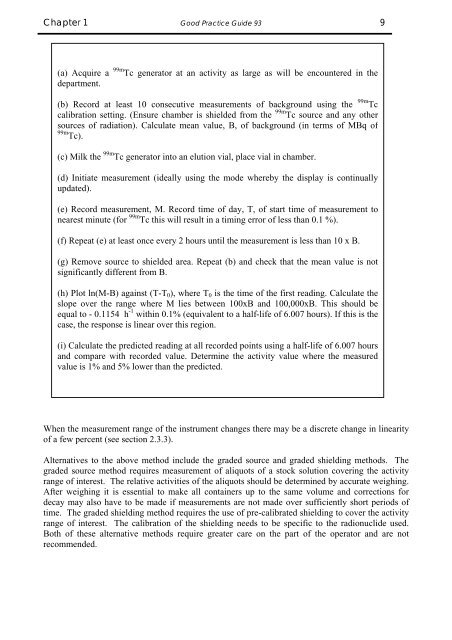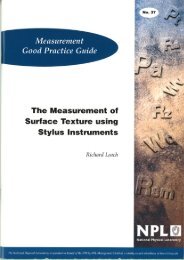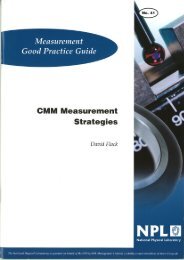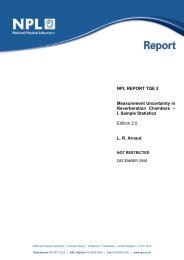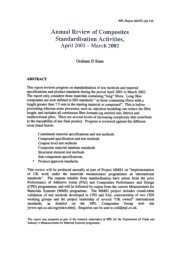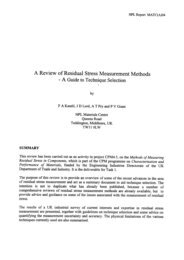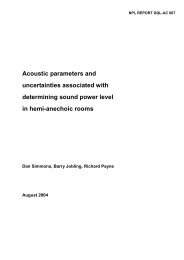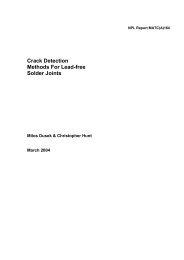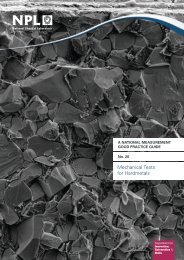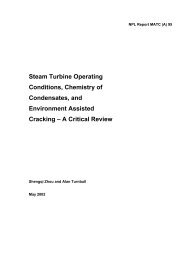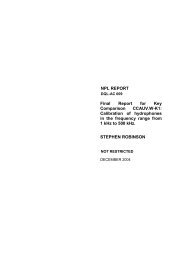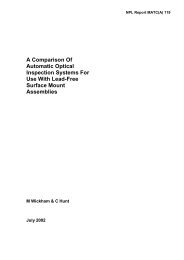Protocol for Establishing and Maintaining the Calibration - NPL ...
Protocol for Establishing and Maintaining the Calibration - NPL ...
Protocol for Establishing and Maintaining the Calibration - NPL ...
Create successful ePaper yourself
Turn your PDF publications into a flip-book with our unique Google optimized e-Paper software.
Chapter 1 Good Practice Guide 93 9<br />
(a) Acquire a 99m Tc generator at an activity as large as will be encountered in <strong>the</strong><br />
department.<br />
(b) Record at least 10 consecutive measurements of background using <strong>the</strong> 99m Tc<br />
calibration setting. (Ensure chamber is shielded from <strong>the</strong> 99m Tc source <strong>and</strong> any o<strong>the</strong>r<br />
sources of radiation). Calculate mean value, B, of background (in terms of MBq of<br />
99m Tc).<br />
(c) Milk <strong>the</strong> 99m Tc generator into an elution vial, place vial in chamber.<br />
(d) Initiate measurement (ideally using <strong>the</strong> mode whereby <strong>the</strong> display is continually<br />
updated).<br />
(e) Record measurement, M. Record time of day, T, of start time of measurement to<br />
nearest minute (<strong>for</strong> 99m Tc this will result in a timing error of less than 0.1 %).<br />
(f) Repeat (e) at least once every 2 hours until <strong>the</strong> measurement is less than 10 x B.<br />
(g) Remove source to shielded area. Repeat (b) <strong>and</strong> check that <strong>the</strong> mean value is not<br />
significantly different from B.<br />
(h) Plot ln(M-B) against (T-T 0 ), where T 0 is <strong>the</strong> time of <strong>the</strong> first reading. Calculate <strong>the</strong><br />
slope over <strong>the</strong> range where M lies between 100xB <strong>and</strong> 100,000xB. This should be<br />
equal to - 0.1154 h -1 within 0.1% (equivalent to a half-life of 6.007 hours). If this is <strong>the</strong><br />
case, <strong>the</strong> response is linear over this region.<br />
(i) Calculate <strong>the</strong> predicted reading at all recorded points using a half-life of 6.007 hours<br />
<strong>and</strong> compare with recorded value. Determine <strong>the</strong> activity value where <strong>the</strong> measured<br />
value is 1% <strong>and</strong> 5% lower than <strong>the</strong> predicted.<br />
When <strong>the</strong> measurement range of <strong>the</strong> instrument changes <strong>the</strong>re may be a discrete change in linearity<br />
of a few percent (see section 2.3.3).<br />
Alternatives to <strong>the</strong> above method include <strong>the</strong> graded source <strong>and</strong> graded shielding methods. The<br />
graded source method requires measurement of aliquots of a stock solution covering <strong>the</strong> activity<br />
range of interest. The relative activities of <strong>the</strong> aliquots should be determined by accurate weighing.<br />
After weighing it is essential to make all containers up to <strong>the</strong> same volume <strong>and</strong> corrections <strong>for</strong><br />
decay may also have to be made if measurements are not made over sufficiently short periods of<br />
time. The graded shielding method requires <strong>the</strong> use of pre-calibrated shielding to cover <strong>the</strong> activity<br />
range of interest. The calibration of <strong>the</strong> shielding needs to be specific to <strong>the</strong> radionuclide used.<br />
Both of <strong>the</strong>se alternative methods require greater care on <strong>the</strong> part of <strong>the</strong> operator <strong>and</strong> are not<br />
recommended.


